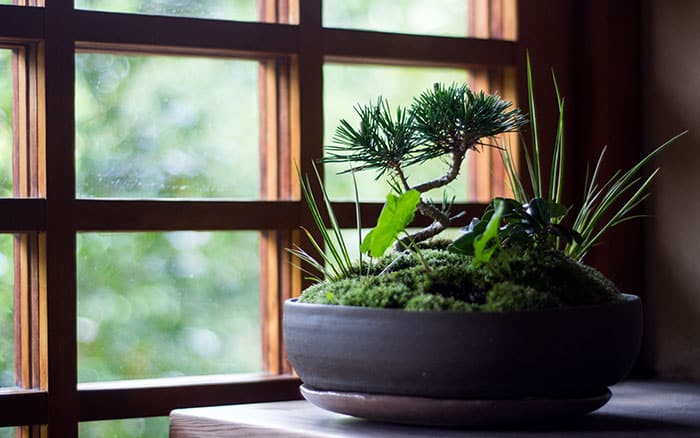Bonsai trees are instantly recognisable, generally identified as miniature trees growing in the home or garden. It’s an art form with a long history, and today many people are bonsai enthusiasts all over the world. Studies have shown that those that practice bonsai experience lower levels of anxiety and depression, therefore supporting the links between bonsai and the mind. Here’s a guide to growing bonsai trees.
History of bonsai
The word bonsai comes from the Japanese terms bon ‘tray’ and sai ‘planting’. Although the word is Japanese, the art actually has Chinese roots. The history of this method of cultivation can be traced back nearly 3,000 years ago. Since then, plants have been cultivated in China to imitate natural landscapes. This art form is known as penjing or penzai. For example, Shanshui penjing is landscaping which involves creating miniature landscapes with rocks that are selected or shaped, with water, and then small plants to complete the illusion.
It’s thought that with Buddhism expanding from China into Japan, that new plants were introduced, and therefore new art forms with those plants.
By the Edo or Tokugawa period which lasted from 1603-1867, potting up small trees as bonsais and gardening were incredibly popular, especially for the wealthy. Then as the 20th Century came around, the practices of bonsai were loved and appreciated across the world, as they are today.
They made their way into the western world through printed art, like through block prints and illustrations from those travelling the countries.

Bonsai trees to grow
One of the biggest mistakes made when growing bonsais is incorrect positioning of them. Some bonsais are for outdoor growing, whilst others will happily grow as houseplants. Bonsais of plants like oak need an outdoor position, whereas figs, ficuses, and dwarfed houseplants will grow indoors. Ask at your local garden centre the best position for the bonsai you choose and they’ll be able to advise you.
Juniperus (juniper)
The great thing about juniper as a bonsai is that it is tolerant of heavy pruning. Therefore, it’s great to get started with, to learn and practice pruning and wiring.
Junipers suit the art of bonsai well because the foliage is small, which lends itself well to being grown as a miniature tree. This tree is happy grown outdoors in a sunny spot. However, if being kept as a houseplant it will need a bright, direct sunlight for about 3 hours per day. To keep it growing its best, water when the soil begins to dry out.

Prunus serrulata (Japanese flowering cherry)
The Japanese flowering cherry is one of the best bonsais. Not only do they look stunning, with the ornamental blooms, but they are easy to train too. The branches and trunks are easy to shape. These can be grown indoors but will appreciate being moved outdoors over summer so they have access to the sun, which will increase flowering. Keep them in a sunny spot and water frequently to keep the soil moist.

Ulmus parvifolia (Chinese elm)
These are popular for bonsai beginners because they are easy to cultivate. Although it’s worth bearing in mind that they require regular pruning to keep its rounded shape. These prefer a cooler room, and the soil should be kept moist and not allowed to dry out.
The Chinese elm can be grown indoors or outdoors, as long as it has a sunny position. A great thing about this plant is that it is drought tolerant, however it will benefit from deeper waterings less frequently. This makes it a great option for busy households.

Ficus retusa (Ginseng Ficus)
The Ginseng Ficus is commonly seen in garden centres, as a common starting place for beginners to the art. They are hardy and tolerate a lot, making them great to practice on. The aerial roots offer much interest, meaning it’s not only the foliage that makes this a striking choice.
Another selling point of using this Ficus is that they will tolerate neglect if the watering schedule isn’t regular. This is one of the best types to grow as a houseplant because it thrives in warm and bright spots.

Ficus benjamina (weeping fig)
The umbrella-shaped canopy of this tree makes it an aesthetically pleasing pick as a bonsai. It’s not only the foliage that provides interest, but also the roots which look tangled upon the surface, having a really interesting appearance.
This is another one that can be grown as a houseplant all year round in a sunny spot. Water regularly to keep the compost moist.

Caring for bonsai
The art of growing dwarf trees does require more care and maintenance compared to succulents, however it’s well worth the effort. Generally, they need plenty of light, humidity, and regular watering to keep them thriving. To increase humidity, you can place the bonsai on a tray filled with gravel and water or mist the tree daily. However, the care will differ for each type, as shown above.


Leave A Comment